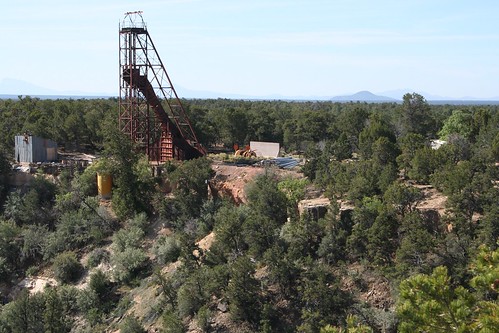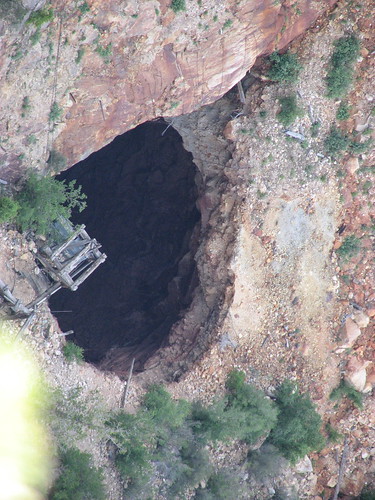
It's this.


These are photographs of Orphan Mine, an abandoned uranium mine on the South Rim of the Grand Canyon. Mining stopped there in 1972, but the environmental impact continues today:
Visitors walking along the canyon rim must detour around the site. The large headframe and other structures on the site attract curious visitors. The chain-link fence around the mine workings is often in a state of disrepair, and is only partly effective where it joins the rim. Hazards: The main shaft is 1,500 feet deep and is accessible via a ladderway exposed just below the canyon rim. The remaining structures, foundations, and trash also present physical hazards. Radiation levels are elevated throughout the compound and in a visitor-use area to the west, with combined beta and gamma sometimes exceeding 3.0 mR/hour.... Resource Impacts: Approximately ten acres of land on the rim are radiologically contaminated (in excess of 0.057 mR/hour) with ore and waste rock.Bush is in a rush to ensure that Orphan Mine is only the beginning:
The Bush Administration is rushing forward with plans to mine the Grand Canyon for uranium, ignoring a command from Congress to cease such operations. Since 2003, mining interests have staked out over 800 uranium claims within five miles of Grand Canyon National Park. As Mineweb reports, “The Bureau of Land Management has published a proposed rule which rejects the House Natural Resources Emergency House Resolution enacted in June that bans uranium mining and exploration near the Grand Canyon National Park.” The Arizona Republic explains what’s at stake:
Never mind that the drinking water of more than 25 million people, served by the Colorado River, is at risk.
Or that Arizona Game and Fish warns about the impact on wildlife.
Or that Grand Canyon National Park is still dealing with the toxic mess from past mines.
The proposed BLM rule would not only reject the House’s emergency withdrawal of over one million acres of federal land near Grand Canyon National Park from new uranium mining, but also eliminate the provisions that allow Congress to make such withdrawals in the future. The proposed rule, published on Friday, has a remarkably short comment period, closing in less than two weeks on October 27. House Parks Subcommittee Chairman Raúl Grijalva (D-AZ) blasted BLM’s action, saying, “This last-minute move by this ‘see if we can get it under the clock‘ administration is cowardly.”
Cowardly, opportunistic, and so very Bush. He is, once again, defying Congress and trying to impose his will by fiat. He is, once again, demonstrating his reckless disregard for the environment. He doesn't care that the Grand Canyon is an irreplaceable natural wonder. He doesn't care that communities such as Flagstaff depend on the tourism the Canyon brings. He doesn't care that Native Americans still live on that land, and that to them, it is sacred.
We have only a week to speak out for the Grand Canyon. You can submit a written comment online here (click the yellow dialogue bubble by "Add Comments"). Some good talking points can be found here.
The environmental impact of uranium mining in Grand Canyon National Park can't be overstated. This is fragile land, and once destroyed, it can't be reclaimed.
Water quality. Water in Arizona is scarce and precious. Uranium mining will contaminate Colorado River tributaries and the local water table. Uranium levels in creeks contaminated by Orphan Mine are 3 higher than the USEPA drinking water standard.
Flooding. Northern Arizona is prone to flash floods, and the Grand Canyon suffers landslides. In 1984, a flash flood washed four tons of uranium ore from a mine in Hack Canyon. That ore has concentrations of uranium 2,000 - 3,000 times greater than the levels in natural soils, and it ended up washed into creeks that provide water to thousands of people.
Landscape. The damage is not limited to the mines alone, although that's eyesore enough. Roads have to be built to those mines. Dust from those roads fills the air, reducing visibility at the Canyon. Powerlines are strung across once unobstructed vistas. Public land is removed from public use, posted with No Trespassing signs, and spoiled for generations due to dangerous debris and radioactive contamination.
Reclamation. In Arizona, the idea of "reclaiming" mined land is a sick joke. The topsoil, as one BLM architect has noted, is far too thin for reclamation cover. Attempts at revegetation fail due to low rainfall and invasion by intruder species. Even those invaders can't hold the soil together, and Arizona's sporadic but heavy rains cut right through ground not held together by healthy root systems. Drastic erosion results in gullies several feet deep. It's not only ugly, it exposes the radioactive waste meant to be "reclaimed."
Native flora and fauna. You can imagine what all of the above does to native species, not to mention Native Americans.
That's just a brief summary from supplemental testimony sent to Congress by Chris Shuey from the Southwest Research and Information Center. If you search the intertoobz, you'll come across several more impact statements, all just as depressing, if not more.
The Grand Canyon is enjoyed by millions of visitors from around the world. It's home to many plants, animals and people. It's one of the most spectacular vistas on Earth, and the last thing it needs is to be strewn with uranium mines. Let the BLM know that this end-run around Congress in order to let mining interests take over a national natural treasure won't be tolerated.
And please help me spread the word. Bush's plan to give the Grand Canyon to mining interests isn't an Arizona issue, or an American issue: this Canyon belongs to the world.
Don't let him take it from you.









No comments:
Post a Comment